Even Dirty Harry needs an occasional day off from the intensity of magnum handgun recoil. And I’m presuming that’s when he reaches for his box of 44 Special cartridges. Fast forward 46 years and today’s “most powerful handgun in the world” is even more intense: the 500 S&W Magnum. This is where 500 S&W Special comes in handy- to “tame the beast”.
500 S&W Special Overview
If you are familiar with both 44 Special and 44 Magnum, the 500 S&W Special concept will be a familiar one. Just like 44 Special is a shortened version of 44 Magnum, 500 S&W Special is just a shortened version of the 500 S&W Magnum. What’s different is order in which the magnum version and the special version were released. 357 Magnum was released after 38 Special just like 44 Magnum was released after 44 Special. In the case of the “big 500”, Smith and Wesson released the full power 500 S&W Magnum first, where the 500 S&W Special was released later as an alternative cartridge for optimized reduced loads. While it is conceivable there could be firearms chambered in 500 S&W Special, I am not aware of any factory offerings as of this writing.
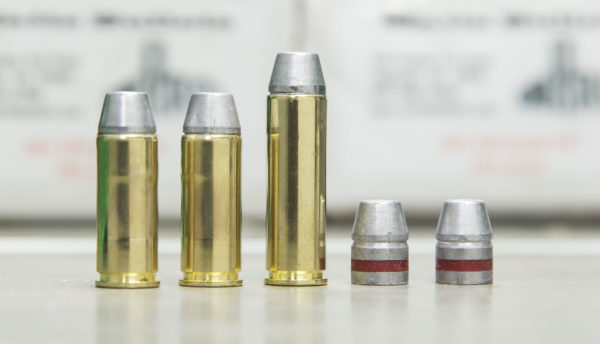
Above you can see 500 S&W Special (two cartridges on left) next to 500 S&W Magnum (cartridge on right), next to a couple of 335 grain lead bullets from Matt’s Bullets. Interestingly, the proportions of the 500 S&W Special look similar to the 44 Magnum, just scaled up quite a bit. Let’s take a quick look at the specs for 500 S&W Special compared to 500 S&W Magnum:
- 500 S&W Magnum case length: 1.625″
- 500 S&W Special case length: 1.274″
- Difference in case length: 0.351″
All other specs are the same between 500 S&W Special and 500 S&W Magnum. Since there are no factory firearms chambered in 500 S&W Special, you’ll inherently run into the same issues you would shooting 38 Specials out of a 357 Magnum firearm, or when shooting 44 Specials out of a 44 Magnum firearm: namely “crud rings”. This phenomenon occurs due to the portion of the chambers which are larger in diameter for the case which extend beyond the case mouth for the shorter cartridges. Hypothetically, you could also suffer degraded precision (larger group sizes) due to the “freebore effect”. I doubt that’s a big factor here, and would love to perform such testing- perhaps I need a Ransom Rest? 🙂 Overall, the 500 S&W Special has performed great in my 8 3/8″ 500 S&W Magnum revolver. The only downside I see is the “crud ring” issue which is not a big deal if you perform regular cleaning.
Reloading Dies for the 500 S&W Special
Reloading the 500 S&W Special is pretty much like reloading 500 S&W Magnum with two exceptions: load data is scarce, and not all dies will work with the shorter 500 S&W Special cases. I found the RCBS to be the only manufacturer offering dies specifically designated to work with both 500 S&W Magnum and 500 S&W Special. Here’s the dies that I use to reload 500 S&W Special:
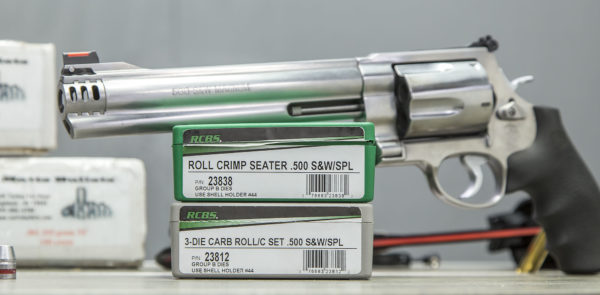
The RCBS #23838 die set is a 3-die set which includes a carbide sizer/de-primer, an expander (for jacketed bullets, see below), and a seater/crimper die. Because I like to separate seating and crimping operations, I also acquired an additional seater/crimper die, RCBS #23812. One thing I learned after getting these dies is that RCBS does not currently make an expander for 500 S&W (Magnum or Special) optimized for lead bullets. The expander that comes with the #23838 die set is optimized for jacketed bullets- so these expanders don’t “bell” the case mouth in a fashion suitable for lead bullets. I saw that a slight modification of the expander would enable the use of the taper built into the expander stem, so I did some quick work on the expander with my 1947 South Bend metal lathe. Here’s the result:
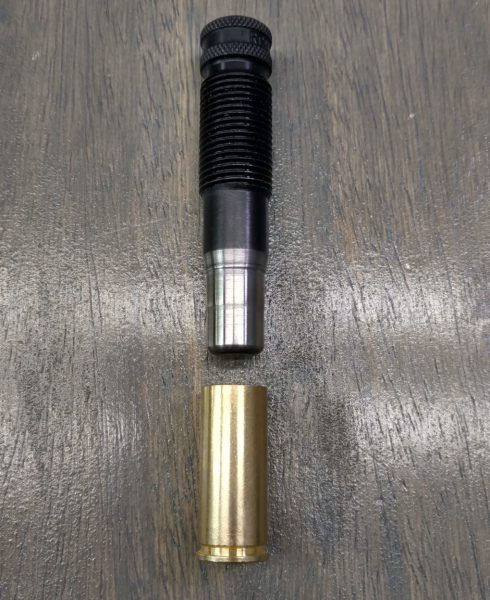
After taking some brass measurements I settled on a two-step profile to accommodate the case wall thickness (increases about 3/8″ away from case mouth) transition for this Starline 500 S&W Special brass. This modified expander worked perfectly! If there is enough interest, I can talk to RCBS about producing these types of expanders from the factory. I wasn’t surprised to have to do some fitting and modification since I am in a sense “charting new territory” here with a specialty cartridge *and* a non-standard bullet (factory 500 S&W Magnum ammunition all seems to use either jacketed or plated bullets).
Reloading the 500 S&W Special
If you have a 500 S&W Magnum revolver you *need* to reload your own ammunition. That’s my opinion. If you reload, you’ll have the ability to tailor your ammunition to your preferences, and you’ll save a *TON* of money. How much can you save reloading 500 S&W Magnum/Special compared to factory ammunition? Here’s a comparison:
- 500 S&W Magnum factory ammunition: ~$1.50/round (on the cheap side) = ~$75.00/box of 50.
- 500 S&W Magnum/Special reloads (shown in this article) = $16.19/box of 50.
This assumes you’re using the 335 grain lead bullets from Matt’s, and that you’re re-using brass. If you shoot one box a week (why wouldn’t you???) that’s a savings of over $3000/year. Yes, specialty ammunition is where you’ll reap most benefit from reloading! Now that we’re all convinced reloading is a good idea, let’s get into specifics! First, a quick run-down on the gear and components I used for this article:
- Press: RCBS Pro-Chucker 5 5-station progressive
- Shellplate: RCBS #44 for the Pro Chucker 5
- Dies: RCBS #23838 die set + RCBS #23812 seater/crimper (together make a 4-die set)
- Powder: IMR Trail Boss
- Primers: Federal Large Rifle
- Cases: Starline 500 S&W Special, Starline 500 S&W Magnum
- Bullets: Matt’s Bullets 335 grain Truncated Cone .501 lead
- Extras: Custom 0.351″ die shims (aluminum)
Here’s the die station utilization for the loading I did (both 500 S&W Special and 500 S&W Magnum):
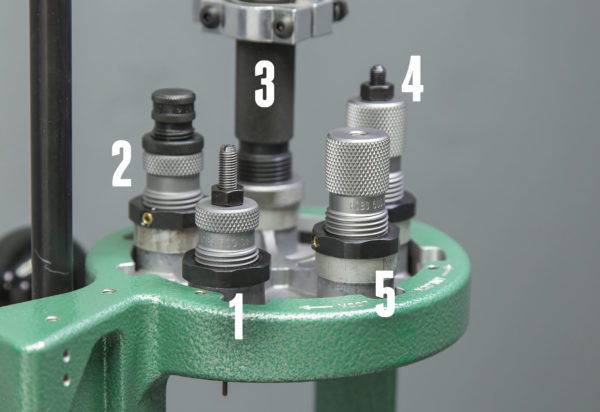
Here’s the station breakdown:
- Station 1: Sizer de-primer
- Station 2: Expander
- Station 3: Powder measure
- Station 4: Seater (crimp not used)
- Station 5: Crimper (seater plug removed)
In the above picture, you can also see the die shims installed- as you might expect, they are used when switching from 500 S&W Special to 500 S&W magnum. Note that you don’t need a shim in station #1 (sizing/de-priming) because a sizer die has to act full-length and the adjustment does not depend on case length. I was able to insert the shims (about 3 minutes total for the changeover) and go straight to loading. No adjustments were needed after the shim install! That’s the way to do it.
For a long time, I’ve wanted to try IMR Trail Boss powder. Why? Two reasons: this bulky powder makes it hard/impossible to double charge, and also provides optimal load density for low-charge-weight loads. This was the perfect opportunity to give Trail Boss a try!
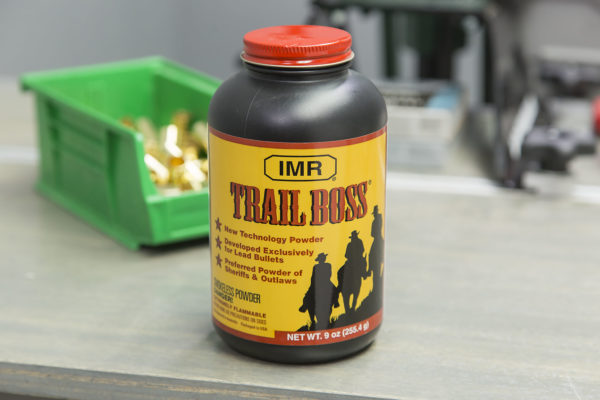
If I were to use a powder like CFE-Pistol, Bullseye, or HP-38 for this application, you’d hardly be able to see the charge in the case, and there would be a lot of air space in the case after loading. With Trail Boss, the 500 S&W Special case was nearly full to where the base of the bullet seats, and the 500 S&W Magnum case was just over 1/2 full as seen here:
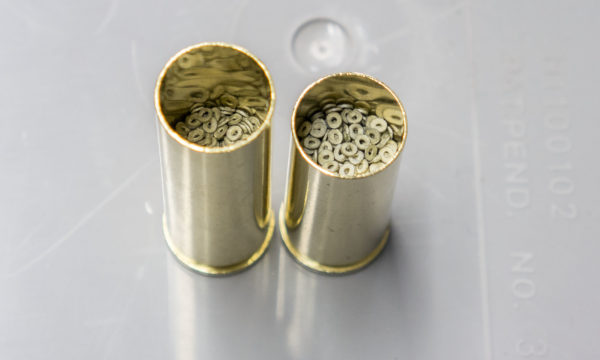
You can see in the above picture how Trail Boss is designed to “bulk up” – it’s granules are like tiny flattened donuts. This causes the powder to take up more space compared to a conventional powder (ball, flattened ball, or flake) in the same burn rate range. I’m curious to try Trail Boss in other cartridges like 38 Special where the same issues of load density and safety are inherent.
Once the press was setup, it was smooth sailing and fast loading. I’ve loaded 500 S&W Magnum on three presses now, including a turret, and I’ll have to say progressive loading is FAST! The 335 grain bullets from Matt’s have a generous crimp groove, and the RCBS seater/crimper die applies a really nice roll crimp. It’s always nice when things come together smoothly!
Load Data and Performance
I tried two loads using IMR Trail Boss: here’s the summary for the loads I tried:
Medium 500 S&W Special Load Data
- 10.0 grains IMR Trail Boss
- Starline 500 S&W Special and Magnum Cases
- Matt’s Bullets 335 Grain Truncated Cone (.501) Bullet
- *Federal Large Rifle Primer
- 1.625″ (Special), 1.977″ (Magnum)
*Note that you can also use a large pistol primer for 500 S&W Special, and use of Large Rifle Primers may cause high pressure depending on the load. This load data is not verified (was developed by myself) so use at your own risk.
Use load data at your own risk. Ultimate Reloader is not responsible for errors in load data on this website. Always cross-reference load data with manufacturer’s published data.
Medium 500 S&W Special Load Performance
Here’s the performance data as observed in the video:
- 500 S&W Special brass (5-shots): 987 fps average, 7.0 fps Standard Deviation
- 500 S&W Magnum brass (5-shots): 939 fps average, 10.3 fps Standard Deviation
For minimal recoil, I decided to further reduce my load, targeting 800-850 fps as a reasonable “stopping point” in powder charge reduction. Some quick experimentation got me headed in the right direction!
Light 500 S&W Special Load
Based on the load above (as shown in video), I reduced the powder charge from 10.0 grains down to 8.8 grains. This reduced velocity by approximately 110 fps- taking it into the low-800-fps range I was looking for. I still need to do more chronograph work to compare the 500 S&W Special brass to the 500 S&W Magnum brass for this load, but it looks like a winner for light target work.
Summary
Like anything else related to ballistics, reloading, and load development: my work is not done with 500 S&W Special! That’s what makes reloading so fun- there’s always something new or different to try, and you can always improve on something whether it be the load, the process, the shooter, or the firearm. It’s a lifetime journey. Look for more 500 S&W Magnum/Special here on Ultimate Reloader, I’ve got more to share and more work to do as well!
Thanks,
Gavin
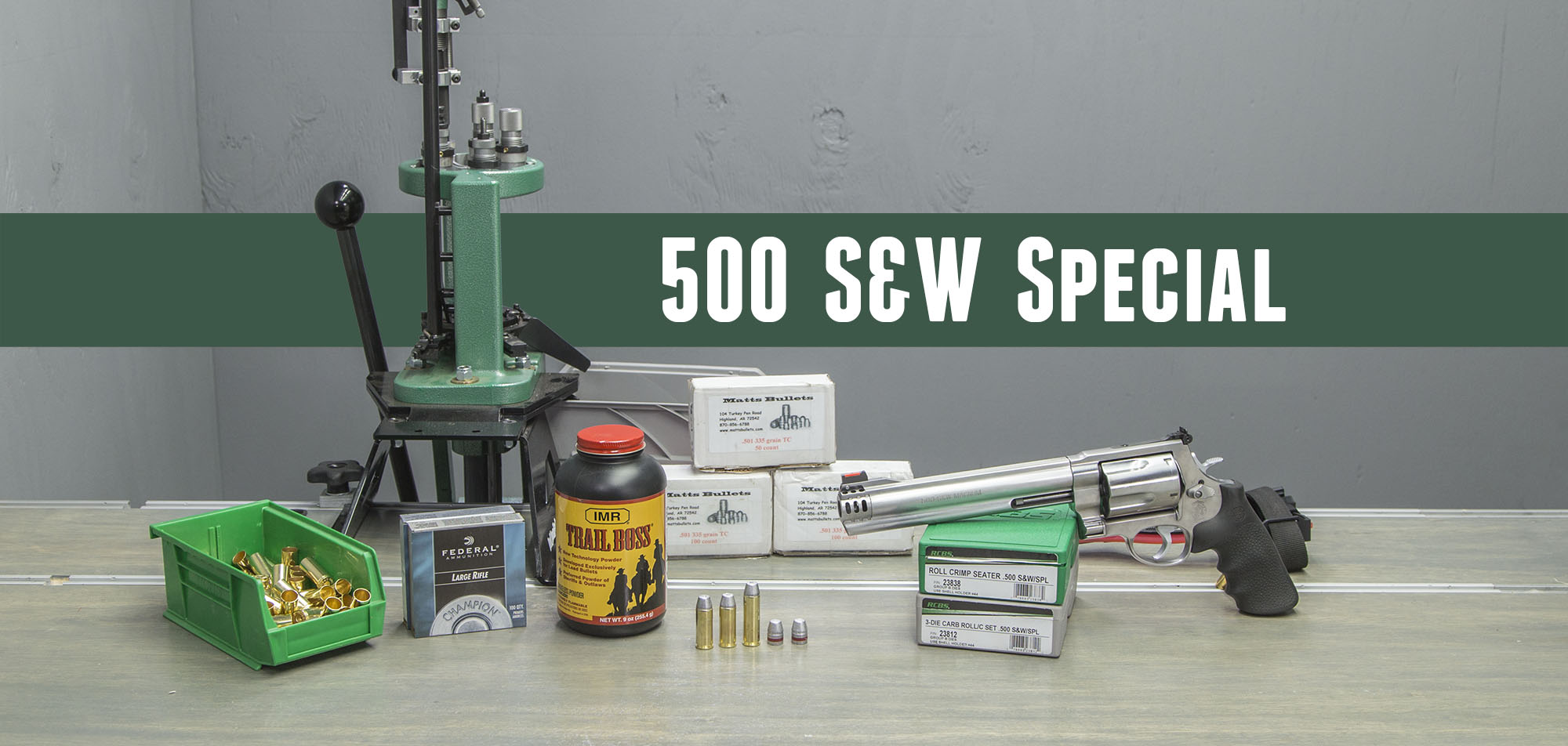


















































































Having been reloading for my 4″ model for several years, this intrigues me. After running enough through the beast to where the .44s feel like toys. I’d love to find something that doesn’t ‘beat the Hell outta me…’ I also have just recently been working with Trail Boss, but in .45 ACP. Love it, and you’re correct in that it will provide a bit of a platform for the bullet prior to seating for the big girl.
I had vainly searched the web for something on the ‘larger’ side of things for a ‘bear load’ here in Montana. I settled on a .500 cal. Lead Spire Point @ 540 gr being pushed by 28 gr of IMR 4227. It’s a handful, but manageable.
Thanks for taking the first steps as I will be working that way myself. I know my wrists and paws will thank you as well…
Gavin,
Thanks for the reply. Have a question for you what would I have to do for you to make me spacers (die shims) that go under the dies for the 500 special.I would do it but no lath or mill.
I too would be interested in paying you to make a set of shims, as I dont have a lathe(yet)
Hi, Gavin just get s&w 500 . I am steel having problem with the Expander die .I need help.Great videos keep them coming.
What problem are you having?
What is the final OD for the expander? May not be as critical for the 500 Special but for the 500S&W .501 is the same for most bullets and do not give the adequate grip of the bullet with a good crimp, allowing for full burn of powder.
Any thoughts?
Very good video and post.
Thanks
Since I am a 50-70 fan, I use a 50-70 expander die to slightly bell my brass. Works great
Hi Gavin. I’m planning on loading some 50 specials with Titegroup and 335 gr Rainier Plated Hollow Point bullets. I would like to start with 7.5 gr of Titegroup. Does that seem reasonable? Would you have any recommendations for a starting load of CFEPistol? Enjoy your videos, keep em coming.
Great article. I too have been using the RCBS dies for loading 500JRH (which is just a little shorter than his big brother at 1.4 in case length). The dies set with the extra crimp die works flawlessly on these rounds. I have been working up Trail boss loads for it as well.
Is there any 500 s&w load data for this 335 gr. Bullet using unique?
That 10 grains of Trail Boss is a compressed load with the 335 matts bullet.
Sir do you have any more load data for the .500 S&W Special since this article.
I’m looking for some reloading data for either the speer or hornady 300 hp. I’d like to run in the 1200 to 1500 fps if possible, I have win 296, Hodgson longshot powder right now. Any help would be appreciated.